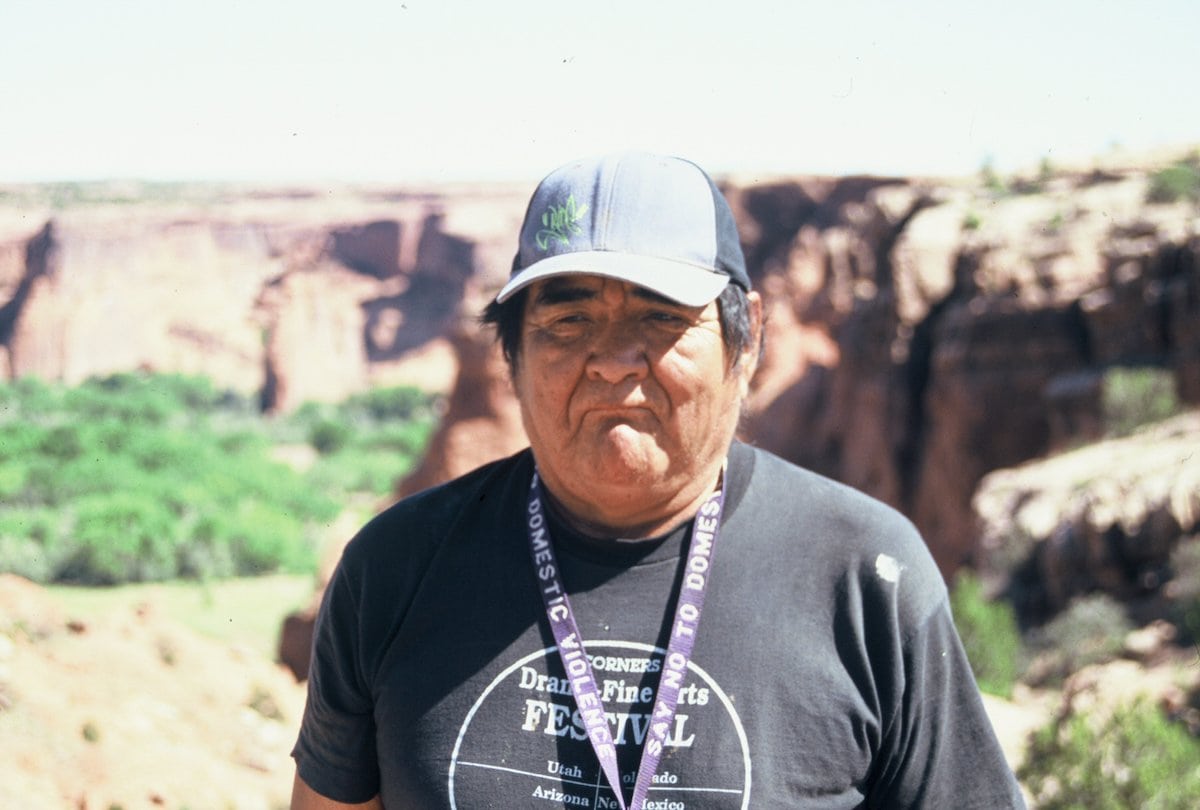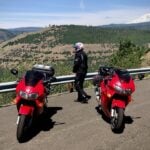The Secrets of Canyon de Chelly
There are some places on this planet that defy description. They are unexpected, ostensively in a different realm. Canyon de Chelly (pronounced “d’shay”), hidden deep within the vast Navajo Nation, is an epic wonder created by shallow seas that advanced and retreated over millions of years, leaving behind deep layers of scarlet stone. Of course, all wonders, natural and unnatural, are best seen from the saddle of your bike, or in my case, a Vampire.
The Victory Vampire is a wicked creation birthed from a childhood gone wrong. It began as a 2005 8-Ball, but was twisted and transmuted into a Victory prototype, a 100 cubic-inch (1639cc) way out-of-the-box skunk works project that shape-shifted to fit the factory’s lineup. Victory has given way to Indian under the Polaris umbrella, but the production prototype Victory Vampire still wanders in constant thirst.
The mission was to build a chopper unlike most choppers. It had to be town and touring comfortable, would handle relatively well, possess blinding power, and it had to roll nationwide. It had to be capable of rides far beyond the usual questionable-joint destinations for bikes of this build. The handlebar was pulled back for easy reach, floorboards rather than pegs were used, and the steering geometry carefully measured and tweaked for optimum agility, at least for 12-inch over forks and the rest of the neck and spine mods.
Behold the beast. 2005 Victory Vampire.
From the towering formations that stand sentinel in Monument Valley to the majestic red sandstone walls and seasonally green valley floor of Canyon de Chelly, the Navajo Nation is a biker’s paradise. This less-visited canyon, its soaring cliffs and mystifying spires, was my destination.
I rolled north out of the red rock wonderlands of Sedona, AZ, up Oak Creek Canyon, one of the prettiest stretches of road in the country, then a jog east along Route 66 through Flagstaff, home to some 600 dormant volcanoes, continuing north on Route 89 to the old trading post at Cameron. This little village stands as the doorstep to the great Navajo Nation, our largest Native American reservation. Stopped in for some souvenirs and the fry bread and mutton stew, a local favorite. Belly full and pockets lighter, back north on 89 to Route 160, then riding east through the twisting blacktop, craning my neck toward the Painted Desert to the south and the petrified red and white dead ocean reefs to the north.
This land is stark, harsh, and beautiful.
A signpost up ahead signaled something bewildering: “Dinosaur Tracks Next Left!” This was an unexpected marvel. I’ve long thought the terrible lizards could still be hanging around, stealthy and sneaky. Just a few miles before the busy reservation town of Tuba City lay the exposed claw-prints of creatures that roamed what was a tropical shoreline tens of millions of years ago, buried under tons of sand and silt long since turned to rock. Erosion finally unearthed the tracks, which can be seen everywhere. So, not fresh tracks.
When crossing endless miles of a burning desert that once lay at the bottom of an ancient shallow sea, things can appear through the wavy haze of heat, amazing, soul shaking things, great visions and small monsters that exist only to bite, sting and drain the life out of you. Mirages will rise up in the horizon, seeming as real as the steel and iron huffing beneath you, then vanish in the next blink of a tired, dusty eye.
Here, nothing is as it seems.
Infinite expanses of petrified sand and rusted rock, cacti and crawly things unknown, and eternal sky spread out before you, seducing the unwary traveler with the matchless excitement and wonder of an undiscovered frontier. Beware its sweet, deceitful kiss. The high plains desert is as engaging and beautiful as it is cruel and deadly. It will beguile you, bend your mind with unearthly colors and contorted shapes of tortured stone. These are the remains of another world. They can betray reason and good sense. Anything can happen here, and it usually does.
Quoth the Raven “Nevermore.”
The reservation is vast. Thousands of square miles are laid bare and naked for you to see in its stark, unabashed beauty. Neither brush nor tree nor many people stand in the way of the boundless view. There’s no better way to experience such a primeval place. As senses heighten and awareness climbs, it’s natural to feel connected to these surroundings in a spiritual way.
Each corner and curve offers something before unseen, or even understood. If you ride long and far enough through this desert, shapes seem to shift, bizarre rock formations appear then disappear, and creatures that should not exist dwell in the shadows. This is not impossible. Some prehistoric sea and shore life that existed then live now, just refitted for landlubber life, such as scorpions, which will probably live forever, and cacti that evolved from marine species.
Public treasures famous for a time-stilled vision of Earth’s past reside nearby: Arches, Canyonlands, Bryce and Zion national parks in Utah; the Grand Canyon in Arizona, Monument Valley, which crosses Arizona and Utah, and the San Juan Mountains and Mesa Verde in Colorado, among others. They offer delights of ethereal beauty, the exploration of timeworn dwellings, and a taste of modern Native American culture.
Man and machine, prowling the Southwest.
The Vampire rolled with menacing aplomb through the Navajo Nation, which extends into Utah, Arizona and New Mexico, an expanse of some 25,000 square miles of Martian landscapes. Diné Bikeyah, or Navajoland, is larger than 10 of the 50 states in the US. The 16 million acre reservation is home to more than a dozen national monuments, tribal parks and historical sites. The tribe recently expanded into Colorado, purchasing two large ranches so the nation could get closer to Blanca Peak and Hesperus Mountian, both sacred to the Navajo. The Rez is a timeless, stark, eerily beautiful place, a land of canyons, dinosaur ghosts and rock formations that took eons to form.
The Navajo were not the first people to occupy this territory. The Anasazi, a Navajo word for “ancient ones,” inhabited the area for centuries but mysteriously vanished some 700 years ago. The hunter/gatherers also farmed the land, which was fertile in canyons where rivers perennially ran. Ancient ruins are scattered through the Navajolands, usually built to sustain small villages of 10 to 20 people, although some housed hundreds.
We are not the first to have trod this stuff of earth.
The canyon is located in Northeastern Arizona near the Navajo town of Chinle. There is no admission fee and visitors are free to ride to its 11 overlooks dotted along the canyon’s South (37 miles roundtrip) and North (34 miles roundtrip) rims. Visitors can peer over sheer red rock walls that rise up to 1,000 feet, towering over the small streams, farms and Cottonwood stands below. Looking carefully over the edge (there are few guardrails), you can peer into some 250 million years of geologic time and millennia of human history.
The 84,000-acre canyon was created by water cutting through sandstone while the Colorado Plateau was uplifted by plate tectonics, much like the Grand Canyon was formed but on a smaller scale. Add in an earthquake now and then and a couple of million years of wind erosion, and you have the stunning, unearthly rock formations and spires that punctuate the park and give rise to native folklore. Because Canyon de Chelly is smaller than its more popular geologic cousin, it somehow feels more real, while the Grand Canyon is so vast it’s hard to grasp and almost seems not quite there.
Ancient cave dwellings, constructed and inhabited by a people long since perished.
Human habitation of Canyon de Chelly goes back 5,000 years, according to archeologists, well beyond the Anasazi pueblo occupation. They flourished in a near idyllic environment. The canyon walls offered protection from wind, weather and enemies, while a now seasonal river ran through a fertile plain. Fish and game were bountiful, and supplemented by cultivated corn, beans and squash.
But none of this could protect them from the technology of a Spanish military expedition searching for treasure in 1805 that slaughtered 115 Navajos at what is now called Massacre Cave. Some 58 years later famed frontiersman and early TV hero Kit Carson joined in the subjugation of the Navajo in 1863 as American settlements encroached on native lands.
Talking with one of the locals. He was friendlier than he looks.
There are a few remains of the Anasazi, who vanished without a trace around 1300 A.D. after some 600 years of continuous habitation. Theories range from epidemics to extended drought to alien abduction, but there’s no definitive explanation and their disappearance remains a mystery.
The most notable Canyon de Chelly ruin, the White House, is the only place where visitors can enter the canyon without a native guide. Jeep tours, horseback and backpacking trips are available into the canyon floor and are recommended for a more in-depth view of the area’s people, history and geology, but the ruin can also be accessed by foot from White House Overlook. The trail descends some 550 feet and is about 2.5 miles roundtrip, but is fairly strenuous on the return and takes about two hours to complete. Make sure to bring plenty of water if you plan on alighting by boot.
Standing atop the unprotected rim is both awe-inspiring and dizzying.
If you just putt to all the overlooks you can get a good general view of the canyon in about a day and a half. If you want to immerse yourself in the experience several days are needed to hike White House trail, visit all the overlooks and maybe take a jeep tour. The Thunderbird Lodge, just within the park, is recommended.
Joshua
Contacts:
Canyon de Chelly National Monument
928-674-5500
www.nps.gov/cach
Thunderbird Lodge
928-674-5842
www.tbirdlodge.com
*Special thanks to the wicked works of Kent Weeks, who with evil intent
and blessed hands did all the fabrication on the Victory Vampire.
281-477-3590
Lucky Devil Metal Works
We rode together for miles and days, the dark dame and me.

































awesome read. My love for the Victory machines (along with my disgust for Polaris for the way they dumped the brand) compelled me to read this article. I was soon caught up in the work of the author, that I found similar in descriptive talents to one of my favorites, Zane Grey, who penned many great descriptive works about this same landscape i.e. Riders of the Purple Sage. Nicely done
We’ll have to check out Zane Grey’s work. Thanks for the info, David. A true kindred spirit.
Fantastic article !
Thank you Bob! We’re biased of course, but we think Placa is one of motorcycling’s great storytellers, right up there with Egan and Salvatori.
Thank you, Mr. G, your comment is most appreciated. Ride Forever!
Joshua – Thanks for sharing your journey with us. Could you give us the full route, at least the Western mountains?
It was my pleasure, Mike, thank you for reading. Departing Sedona, AZ, the route follows 89A to 89 to 160 to 191. Follow 191 to Chinle, AZ, then signs to Canyon de Chelly. I’m not sure what you mean by “Western Mountains.” The only mountains, the San Francisco Peaks, are skirted when passing through Flagstaff along Route 89. I suggest Google Maps as at least a baseline from wherever you’re based. Stay on the route or explore a few backroads along the way.
Thank you, David, appreciate your kind words, and the generous compliment. Polaris wanted the Indian trademark in 1990s, pretty much like everyone else. Couldn’t get it, so launched Victory. When they finally bought the trademark, it was the beginning of the end for Victory. And that was a shame.